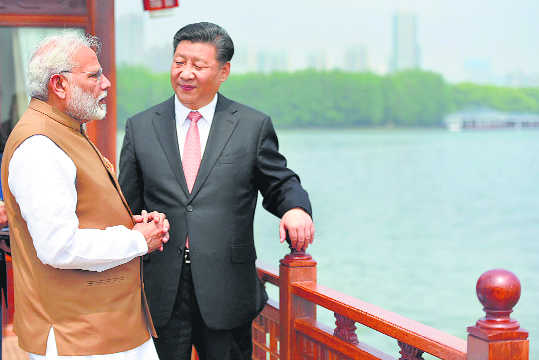
Number game: Three more Xi-Modi talks this year can give a substantial fillip to ties.
Sandeep Dikshit
Informal summits by their very nature are rare. Countries in need of keeping the engines of bilateral diplomacy regularly oiled and greased opt for annual summits like the ones India holds without fail every year with Russia and Japan. The two-day informal summit between Narendra Modi and Xi Jinping would rank more of an event because being peripatetic, they anyway come across each other at several multilateral summits staged all around the globe.
The regional situation must be very pressing for the two leaders to first indulge in extensive rounds of initial spadework with a flurry of top-drawer Indian visitors to China. In classical diplomacy, the one-way traffic to China without carefully measured reciprocal visits translates into the need being greater on India’s part to mend ties. But a glance at China’s diplomatic exertions around the world makes it clear that Beijing has also felt the need to turn the page with other neighbours: overtures to Japan, discussing trade with the US and dialogue with ASEAN on a code of conduct on South China Sea after years of refusing to do so.
Are the two leaders merely buying time for domestic consolidation or is there a long-term game plan that will emerge from at least three more top-level interactions this year, followed by yet another “informal” summit next year?
The short-term prospects look promising. Neither Modi nor Xi can afford external distractions. For Modi, Doklam was a close call to his pretensions of practicing muscular diplomacy. Another confrontation on the one of the many disputed barren tracts on the Sino-Indian border could have cost him his strongman image on the eve of the next general election. On the other side, Xi’s anointment as Permanent President was greeted by a US catnip in the form of a trade whammy and an ever-increasing conglomeration of hostile navies on its western sea flank.
For the longer term, however, both sides need to dispel their ghosts for an element of settlement to appear on the horizon. The first step may have already begun with India instructing its border patrols not to get into entanglements with their opposite numbers in areas over which both sides have overlapping claims. Of all the bilateral inconveniences, none sends public perception in India about China nose-diving than visuals of its soldiers “trespassing” into Indian “territory”. It stands to reason that China should issue similar instructions to keep the Wuhan spirit nominally aloft.
But progress will be limited and even regress till both sides address the other’s fear about mutual encirclement. The past three years of acrimony has tempted both countries to accelerate their plans for foreign military bases. India has a military base sharing agreement with three countries, all of them mutual allies and all wary of the Chinese military. Beijing has responded to the US “Pivot towards Asia” and India’s “Look East” policy by sabotaging India’s plans for a military base in Seychelles, weakening its exclusive security relationship with the Maldives and doubling up on building its bases on the tip of Africa and in Pakistan. In fact, most of the hubs and spokes of China’s Belt and Road Initiative are aimed at reducing its insecurity over the heavy dependence of Chinese tonnage on the narrow Straits of Malacca where Indian and the US navies maintain a perch on its openings at either end.
Even if all the forthcoming interactions with the Chinese President are included, PM Modi will still fall far short of the number of interactions clocked between the Chinese leadership and his predecessor Manmohan Singh who also attempted a similar approach of personal rapport to shore up Sino-Indian ties. Singh’s playbook yielded limited results mainly because it could not cross the red lines erected due to years of suspicion and sporadic political level engagement.
PM Modi has built himself an image of a persuasive go-getter but has found himself at a loss in resolving India’s two major foreign policy conundrums of China and Pakistan. On both fronts, he is making a second effort to resolve the deadlock after three ineffectual years of posturing. But as the UPA found out, Modi is likely to face concerted resistance from within as well as external forces if he attempts to cross some of the red lines.
The BJP-led Union Government may have temporarily turned its back on the Dalai Lama but ever since the CIA began stoking the Khampa rebellion, most of the ideological spear carriers for the Tibet cause hailed from the RSS crowd. This is a psychological barrier that Modi has to cross. China along with Russia has a record number of 14 land boundaries and all its dozen boundary settlements have a common element: extinguishing of threat to its security from the country concerned.
History is replete with instances of minatory quibbling between China and its land neighbours over real estate similar to Doklam and Chumar. But these pinpricks, such as China laying claim on the whole of Mt Everest, vanished once Beijing and the dozen countries in question agreed not to post themselves as security threats to each other. For China, the Dalai Lama and his Tibetan followers in India are one such security threat and that may have precluded a final settlement of the border rather than lack of political will in Delhi.
The Dalai Lama has evoked considerable interest in his statement by claiming that independence is off the agenda of Tibet exiles. Significantly, two days after the Modi-Xi tête-à-tête, US Ambassador to India Kenneth Juster was in Dharamsala to confer with the Dalai Lama and the “Prime Minister” of the Central Tibetan Administration Lobsang Sangay. With the wind of the informal summit behind them, Modi and Xi need to cross the US-China rubicon for a breakthrough that is not just cosmetic but perceptive and verifiable; one that meets the short-term interests of politicians, and also has the capacity and content to cause a meaningful change in people’s lives.



























